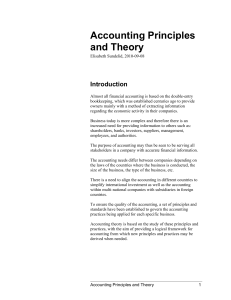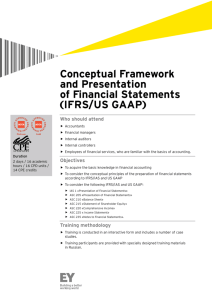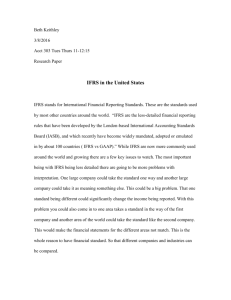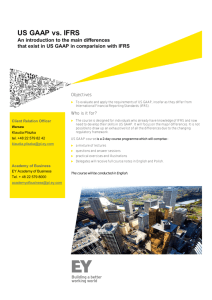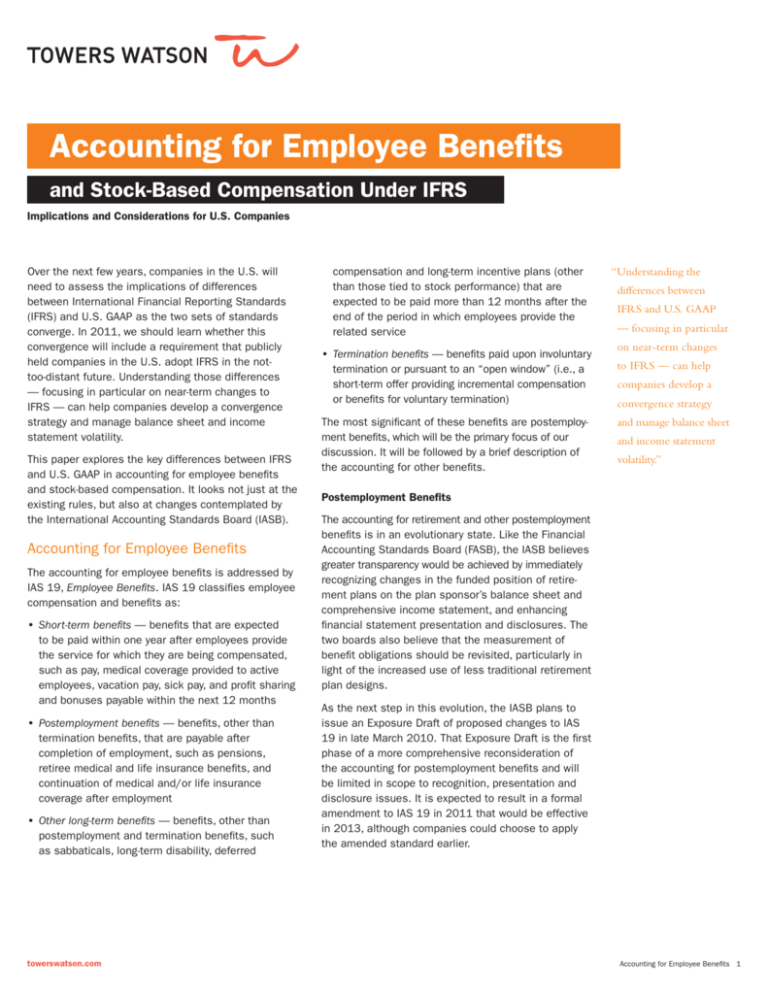
Accounting for Employee Benefits
and Stock-Based Compensation Under IFRS
Implications and Considerations for U.S. Companies
Over the next few years, companies in the U.S. will
need to assess the implications of differences
between International Financial Reporting Standards
(IFRS) and U.S. GAAP as the two sets of standards
converge. In 2011, we should learn whether this
convergence will include a requirement that publicly
held companies in the U.S. adopt IFRS in the nottoo-distant future. Understanding those differences
— focusing in particular on near-term changes to
IFRS — can help companies develop a convergence
strategy and manage balance sheet and income
statement volatility.
This paper explores the key differences between IFRS
and U.S. GAAP in accounting for employee benefits
and stock-based compensation. It looks not just at the
existing rules, but also at changes contemplated by
the International Accounting Standards Board (IASB).
Accounting for Employee Benefits
The accounting for employee benefits is addressed by
IAS 19, Employee Benefits. IAS 19 classifies employee
compensation and benefits as:
• Short-term benefits — benefits that are expected
to be paid within one year after employees provide
the service for which they are being compensated,
such as pay, medical coverage provided to active
employees, vacation pay, sick pay, and profit sharing
and bonuses payable within the next 12 months
• Postemployment benefits — benefits, other than
termination benefits, that are payable after
completion of employment, such as pensions,
retiree medical and life insurance benefits, and
continuation of medical and/or life insurance
coverage after employment
• Other long-term benefits — benefits, other than
postemployment and termination benefits, such
as sabbaticals, long-term disability, deferred
towerswatson.com
compensation and long-term incentive plans (other
than those tied to stock performance) that are
expected to be paid more than 12 months after the
end of the period in which employees provide the
related service
• Termination benefits — benefits paid upon involuntary
termination or pursuant to an “open window” (i.e., a
short-term offer providing incremental compensation
or benefits for voluntary termination)
The most significant of these benefits are postemployment benefits, which will be the primary focus of our
discussion. It will be followed by a brief description of
the accounting for other benefits.
“ Understanding the
differences between
IFRS and U.S. GAAP
— focusing in particular
on near-term changes
to IFRS — can help
companies develop a
convergence strategy
and manage balance sheet
and income statement
volatility.”
Postemployment Benefits
The accounting for retirement and other postemployment
benefits is in an evolutionary state. Like the Financial
Accounting Standards Board (FASB), the IASB believes
greater transparency would be achieved by immediately
recognizing changes in the funded position of retirement plans on the plan sponsor’s balance sheet and
comprehensive income statement, and enhancing
financial statement presentation and disclosures. The
two boards also believe that the measurement of
benefit obligations should be revisited, particularly in
light of the increased use of less traditional retirement
plan designs.
As the next step in this evolution, the IASB plans to
issue an Exposure Draft of proposed changes to IAS
19 in late March 2010. That Exposure Draft is the first
phase of a more comprehensive reconsideration of
the accounting for postemployment benefits and will
be limited in scope to recognition, presentation and
disclosure issues. It is expected to result in a formal
amendment to IAS 19 in 2011 that would be effective
in 2013, although companies could choose to apply
the amended standard earlier.
Accounting for Employee Benefits 1
Current Differences Between IAS 19 and U.S. GAAP
While there are many similarities between the accounting
for benefits provided after termination or retirement
under IAS 19 and U.S. GAAP, there are six key differences. Under IAS 19:
• The effect of plan changes is recognized immediately
for benefits that are vested, and amortized over
employees’ future service to their vesting date for
benefits that are not yet vested. This results in much
more rapid recognition — in fact, immediate
recognition of much or all of the cost of a benefit
improvement or savings from a benefit reduction, in
most cases.
• While gains and losses may be recognized through
P&L immediately or on a delayed basis (with some
differences from U.S. GAAP), a third alternative
allows gains and losses to be recognized immediately
through other comprehensive income (OCI). This is
noteworthy because, unlike U.S. GAAP, the amounts
charged to OCI are not “recycled” through P&L. Thus,
the resulting balance sheet effect is similar to U.S.
GAAP, but without the income statement volatility
arising from gain/loss recognition.
• The fair value of plan assets is used in determining
the expected return on plan assets; there is no
concept of a smoothed asset value. Currently, this
may result in a lower expected return on plan assets
than under U.S. GAAP for companies that use a
smoothed asset value. This is because the fair
value of assets is likely to be lower than a marketrelated value of plan assets that phases in recent
asset gains and losses.
• The expected return on plan assets component of
the net benefit cost is adjusted to reflect actual
contributions and benefit payments (when those
amounts are materially different from the expected
contributions and benefit payments). It is arguably
more logical to adjust the expected return on plan
assets for actual contributions than to recognize a
return on expected contributions that the company
opts not to make in the current year.
• Rather than aggregating the components of cost,
employers may choose to bifurcate them and report
them in different line items in the income statement.
For example, employers may choose to report
service cost as an operating cost, but report interest
cost and the expected return on plan assets as
financing costs.
• The postemployment benefit asset (e.g., prepaid
pension cost) reported on the balance sheet is
limited to unrecognized costs plus the economic
benefit of any plan surplus that is recoverable
through a reduction in future contributions and/or
reversion of any plan surplus (net of related costs,
including excise taxes). The applicability of the asset
ceiling for U.S. plans is still the subject of debate,
but it is clearly an issue for plans in Canada and
parts of Europe.
Expected Near-Term Changes to IAS 19
The IASB expects to issue an Exposure Draft in late
March 2010, proposing several substantive changes
to IAS 19. The proposed changes are expected to
include:
• Net interest income or expense would be measured
by applying the discount rate to the plan surplus or
deficit. This new measure would replace interest
cost and the expected return on plan assets.
• Immediate recognition of all past service cost and
gains and losses. The effect of plan changes would
be recognized through P&L. However, assuming the
IASB moves forward with its view that the comprehensive income statement must be presented as
a single statement,* gains and losses would be
included as a “remeasurement effect” reported
in OCI. In this case, it is possible that gains and
losses could be required to be recognized through
OCI in the interim financial statements.
Similar to the current accounting treatment, the
difference between the actual return on plan assets
and the estimated return would be included in gains
and losses. However, the estimated return would be
based on the plan’s discount rate (usually, highquality bond rates), rather than a rate of return that
considers the plan’s asset allocation.
The resulting balance sheet effects would essentially
mirror the balance sheet under U.S. GAAP, but with
a ceiling on the asset that could be recognized
for certain overfunded plans. However, immediate
* The FASB and IASB are working jointly on a project on financial statement presentation, including the format of a statement of comprehensive income.
An exposure draft of the proposed standard with respect to the format of the comprehensive income statement is expected to be issued in late
March 2010.
towerswatson.com
Accounting for Employee Benefits 2
recognition of the effect of plan changes (and gains
and losses, if the IASB were to converge with the
U.S.) through P&L would introduce more volatility to
the income statement than under U.S. GAAP.
• Disaggregation of the components of cost into:
• An employment component (current and past
service cost and curtailment effects), which
would be included in operating costs
• A financing component (net interest cost), which
would be included in financing costs
• A remeasurement component (actuarial gains and
losses, including settlement effects), which would
be shown separately, net of tax effects, in OCI
• Enhanced disclosures, including sensitivity information
and information useful in assessing liquidity risk and
market risk associated with the plan assets; some
of the disclosures likely to be proposed are more
extensive than those currently required under U.S.
GAAP
Other Benefits
The accounting for short-term benefits is generally
comparable to the accounting most companies follow
under U.S. GAAP. The cost and liability for benefits
that accumulate with service are to be accrued over
the period they are earned, with gains and losses
expensed immediately. The cost and liability for
benefits that do not accumulate with service are
recognized when the triggering event occurs. The
benefit obligation and cost are not discounted.
The accounting for long-term benefits under IFRS
is also generally comparable to the accounting
most companies follow under U.S. GAAP, except the
obligation and cost are required to be discounted
based on high-quality corporate bond rates. The cost
and liability for long-term disability benefits that do
not accumulate with service are recognized when the
triggering event occurs. In all other cases, the cost and
liability for long-term benefits are to be accrued over
the period they are earned, with gains and losses and
the effects of any plan changes expensed immediately.
The IASB will soon issue an amendment to IAS 19
that more closely aligns the accounting for termination
benefits with U.S. GAAP. As a result of these changes,
which will be effective in 2011 but can be adopted
early, the accounting for termination benefits will
generally be consistent under IAS 19 and U.S. GAAP.
towerswatson.com
Stock-Based Compensation
The basic principles underlying the accounting for
stock-based compensation are generally the same
under U.S. GAAP and IFRS 2, Share-Based Payment,
with the exception of the following noteworthy
differences:
• Scope — IFRS 2 applies to all stock-based awards
to employees and nonemployees, including awards
from ESOPs. Under U.S. GAAP, the measurement date,
and measurement and recognition of cost, differ for
grants to employees, awards to nonemployees (such
as independent contractors or other advisors) and
ESOP awards. Grants to nonemployees generally
result in mark-to-market accounting under U.S. GAAP
(until the date the agreed-upon services have been
provided), and special accounting rules apply to
ESOPs. Under IFRS 2, the cost of awards to
nonemployees are measured at fair value at the
date the services are provided and recognized over
the required service period, like stock-based awards
to employees.
• Service period over which compensation cost is
recognized — Explicit guidance is provided under
U.S. GAAP for determining the grant date of an
award and the explicit, implicit and derived service
periods used in determining the service period
over which the cost of an award should be accrued.
IFRS 2 is less prescriptive than U.S. GAAP, leading
to potential differences in the grant date (for
accounting purposes) and ambiguities in the period
over which the compensation cost is to be
recognized.
• Attribution of compensation cost for awards with
graded vesting — Unlike U.S. GAAP, IFRS 2 does
not permit a straight-line attribution approach for
service-based awards with graded vesting. Instead,
each tranche is treated as a separate grant.
• Payroll taxes — Payroll taxes are accrued under IFRS
2 as the related compensation cost is recognized.
This contrasts with U.S. GAAP, which requires
recognition of payroll taxes when the event triggering
the tax payment (e.g., exercise date for nonqualified
options or vesting date for restricted stock) occurs.
• Accounting for certain types of award modifications
— Under U.S. GAAP, award modifications are categorized based on the expectation — immediately
before and after the modification — that the award
will vest. For example, a Type III modification is
Accounting for Employee Benefits 3
one where the expectation an award will ultimately
vest changes from “improbable” to “probable.”
Generally, total compensation cost under U.S.
GAAP for a modified award may not be less than
the fair value of the award at the original grant
date, except in the case of a Type III modification.
For these modifications, the compensation cost is
based on the fair value of the modified award at the
modification date, which may be less than the fair
value of the award at the original grant date. IFRS 2
makes no such distinction; total compensation cost
is at least equal to the fair value of the award as of
the grant date (i.e., the number of modified awards
expected to vest, times the fair value of the awards
at the original grant date) — even for improbableto-probable modifications. In addition, the effects
of any modifications that increase the fair value
of the share-based payment arrangement must be
recognized. This incremental cost is equal to the
increase in the fair value of the award as measured
immediately before and after the modification.
• Deferred tax effects — Like U.S. GAAP, IFRS 2
requires employers to recognize the deferred
tax effects as compensation cost is recognized.
However, under U.S. GAAP, the deferred tax asset
is based on the compensation cost that has been
recognized through P&L (i.e., based on the fair
value of the award at the date it was granted). In
contrast, under IFRS 2 the deferred tax asset (and,
therefore, tax expense) is adjusted at the end of
each reporting period based on the intrinsic value
of the award at that date. As a result, under IFRS 2,
the expected excess tax benefits are recognized as
additional paid-in capital as they arise, rather than
reflecting any actual excess tax benefits all at once
when the award is settled.
• Windfall tax benefits or tax benefit shortfalls —
“Windfall” tax benefits (where the tax deduction
related to an award exceeds the compensation cost
recognized) and tax benefit “shortfalls” (where the
compensation cost recognized for an award exceeds
the related tax deduction) are tracked separately for
each award under IFRS 2, but in the aggregate under
U.S. GAAP. In addition, under IFRS 2, a windfall tax
benefit is recognized in equity whereas a tax benefit
shortfall is recognized in P&L. Under U.S. GAAP, a
tax benefit shortfall first reduces the accumulated
windfall in equity, with only the residual recognized
through P&L.
towerswatson.com
• Employee stock purchase plans (ESPPs) — The
safe harbor under U.S. GAAP — which enables
employers in many situations to avoid expensing
shares purchased by employees through an ESPP if
the purchase discount does not exceed 5% on the
purchase date — does not exist under IFRS 2. As a
result, under IFRS 2, any discount from the fair value
of stock purchased by employees through an ESPP
must be recognized as compensation cost.
Transition to IFRS
IFRS 1, First-Time Adoption of International Financial
Reporting Standards, addresses how companies are to
account for the initial application of IFRS. With limited
exceptions, IFRS 1 requires that an entity that changes
its basis of accounting from a national GAAP (such
as U.S. GAAP) to IFRS must do so by retroactively
restating the prior year(s) as though the IFRS in effect
at the reporting date had always been followed. The
cumulative effect of the change is recognized through
beginning retained earnings of the earliest year
presented, and the comparative financial statements
therefore reflect consistent application of IFRS.
Example: A company adopting IFRS in 2015 would
have to determine the beginning balances of its
assets, liabilities and equity accounts as of January 1,
2013 (the date of transition) in accordance with IFRS in
effect in fiscal 2015. Retained earnings as of January
1, 2013 would be adjusted for changes between the
amounts recognized under U.S. GAAP and the amount
to be recognized under IFRS.
The following exceptions are provided for determining
the transition effect of adopting IAS 19 and IFRS 2
when adopting IFRS for the first time:
• Employers may choose to treat all unamortized
gains and losses under U.S. GAAP as though they
had been immediately recognized through P&L prior
to the transition date, regardless of the gain/loss
recognition policy the employer chooses to follow
prospectively.
• Employers need not apply IFRS 2 to awards granted
on or before November 7, 2002 that have vested at
the date of transition to IFRS or to liabilities settled
before that date.
Accounting for Employee Benefits 4
Final Thoughts
Understanding IFRS and how they would affect your
financial results is critical to developing a successful
convergence strategy. For your benefits and sharebased compensation plans, this encompasses
collecting information about your plans, reaffirming
plans considered to be material, identifying implementation issues, assessing your accounting options (if
any) and selecting accounting policies, evaluating risk
mitigation strategies, reconsidering performance
measures and monitoring IASB decisions.
We look forward to working with you as you assess the
implications of convergence with IAS 19 and IFRS 2.
About Towers Watson
Towers Watson is a leading global professional services
company that helps organizations improve performance through
effective people, risk and financial management. With 14,000
associates around the world, we offer solutions in the areas
of employee benefits, talent management, rewards, and risk
and capital management.
Copyright © 2010. All rights reserved.
towerswatson.com


